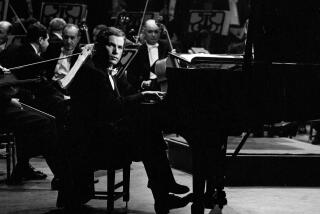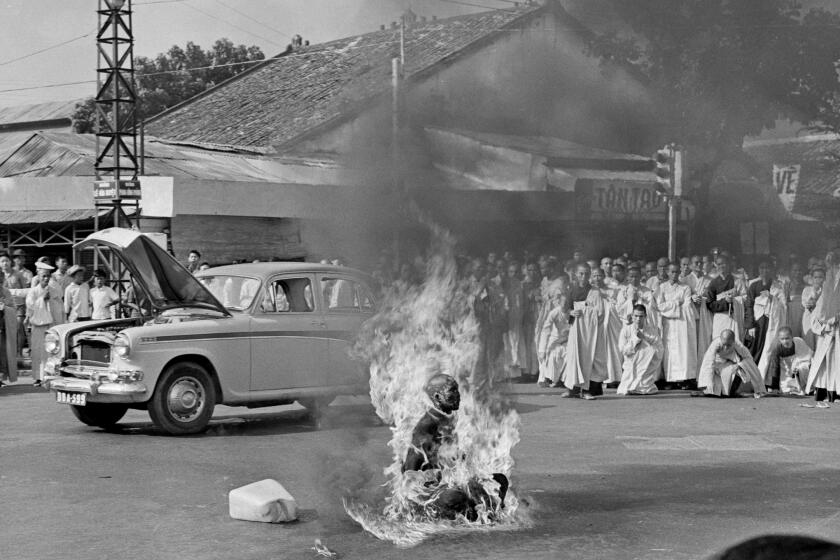Op-Ed: At the 1964 World’s Fair, a phone call to the future
Back in 1964, 50 years ago this summer, my mother, father, sister and I drove from our home in suburban New Jersey to New York City, where we caught a glimpse of the future.
Our destination was Flushing Meadows Park in Queens, the site of the World’s Fair. It all seemed exciting to a boy of 12, but it was at the Bell Telephone Pavilion that I saw something that seemed revolutionary, especially for my family: the Picturephone, also known as the Mod or Model 1.
At the phone exhibit, my father and I stepped into one booth while my mother and sister went into another. We sat in chairs that had been placed in front of a modern-looking oval device containing a small camera and a rectangular video screen. My father pressed the button marked “V” for video on a touch-tone telephone keypad, and my mother and sister appeared on the screen.
Our eyes wide and mouths agape, we waved at one another and spoke excitedly for the next 10 minutes. I left thinking that this device, if it ever became available to ordinary people in their homes, would have far-reaching implications for all kinds of people, but especially for members of the deaf community.
I had a particular interest in the well-being of deaf people. Both my parents were profoundly deaf: my father from birth and my mother from spinal meningitis when she was an infant. My father had enough residual hearing that he could, with a hearing aid, handle phone calls and other interactions, but he was generally out working from early morning until late evening. And so my mother usually relied on me, her oldest child, when she needed to call friends and relatives or make arrangements by phone.
It was a service I often performed grudgingly, resentful at having been pulled away from playing with my toy soldiers or reading the sports pages or watching “Superman” on TV. Most often, the calls she asked me to make were to her mother in Manhattan. Since this was usually to arrange visits, I would have to navigate back and forth between them, conveying logistical information.
My mother always thanked me for the calls afterward, both vocally and in sign language. She would bring her palm flat near her lips and then toward me, as if blowing a kiss. But, after the World’s Fair, I couldn’t help thinking about what a difference a Picturephone would make — to my mother and to me too.
My mother was skilled at reading lips. Wouldn’t it be wonderful if she could just press “V” and talk with her younger brother in Roslyn Heights, or her mother, or her friends throughout New Jersey and Long Island? What’s more, she would be able to contact the police or fire department in case of an emergency. But the Picturephone was impractical for home usage, and Bell never put it into widespread production.
There have been other solutions, though, and far better ones that make the Picturephone seem hopelessly outdated. Deaf people are no longer isolated the way my mother often was. Closed-captioning for television became widely available in the 1970s. So did teletypewriters adapted with a modem to run over phone lines. Cochlear implants have attuned those previously unable to hear to sound. And video chats are simple and inexpensive today on cellphones, tablets and computers.
As it has turned out, the future I wished for as a boy of 12 has arrived. My mother, now 85 and living in Thousand Oaks, relies on a phone that connects to her television and functions as a Picturephone through a video-relay service available to those with hearing impairments.
She converses in sign language regularly and easily with people thousands of miles away. She stays in touch with her childhood friends, Ruth and Alice, both of them also profoundly deaf and still living back in New Jersey. They talk about growing up in the Bronx and bring one another up to date on grandchildren and other family news. All the while, their hands slice and swoop through the air. People who don’t sign can call her service, and an operator appears on the screen, signing what the caller says to her and relaying information back to the caller.
“The videophone makes a big difference in my life,” she recently told me. “Before, when you were a little boy, I always had to ask for your help. Now I feel independent, just like everyone else.”
Bob Brody is an executive and essayist in New York. He’s at work on a memoir about his parents.
More to Read
A cure for the common opinion
Get thought-provoking perspectives with our weekly newsletter.
You may occasionally receive promotional content from the Los Angeles Times.






